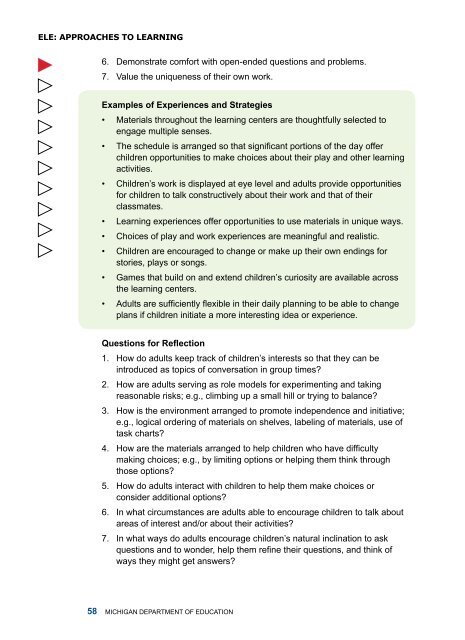Early Childhood Standards of Quality for ... - State of Michigan
Early Childhood Standards of Quality for ... - State of Michigan
Early Childhood Standards of Quality for ... - State of Michigan
Create successful ePaper yourself
Turn your PDF publications into a flip-book with our unique Google optimized e-Paper software.
ELE: Approaches to Learning6. Demonstrate com<strong>for</strong>t with open-ended questions and problems.7. Value the uniqueness <strong>of</strong> their own work.Examples <strong>of</strong> Experiences and Strategies• Materials throughout the learning centers are thoughtfully selected toengage multiple senses.• The schedule is arranged so that significant portions <strong>of</strong> the day <strong>of</strong>ferchildren opportunities to make choices about their play and other learningactivities.• Children’s work is displayed at eye level and adults provide opportunities<strong>for</strong> children to talk constructively about their work and that <strong>of</strong> theirclassmates.• Learning experiences <strong>of</strong>fer opportunities to use materials in unique ways.• Choices <strong>of</strong> play and work experiences are meaningful and realistic.• Children are encouraged to change or make up their own endings <strong>for</strong>stories, plays or songs.• Games that build on and extend children’s curiosity are available acrossthe learning centers.• Adults are sufficiently flexible in their daily planning to be able to changeplans if children initiate a more interesting idea or experience.Questions <strong>for</strong> Reflection1. How do adults keep track <strong>of</strong> children’s interests so that they can beintroduced as topics <strong>of</strong> conversation in group times?2. How are adults serving as role models <strong>for</strong> experimenting and takingreasonable risks; e.g., climbing up a small hill or trying to balance?3. How is the environment arranged to promote independence and initiative;e.g., logical ordering <strong>of</strong> materials on shelves, labeling <strong>of</strong> materials, use <strong>of</strong>task charts?4. How are the materials arranged to help children who have difficultymaking choices; e.g., by limiting options or helping them think throughthose options?5. How do adults interact with children to help them make choices orconsider additional options?6. In what circumstances are adults able to encourage children to talk aboutareas <strong>of</strong> interest and/or about their activities?7. In what ways do adults encourage children’s natural inclination to askquestions and to wonder, help them refine their questions, and think <strong>of</strong>ways they might get answers?58 <strong>Michigan</strong> Department <strong>of</strong> Education


